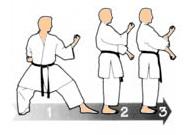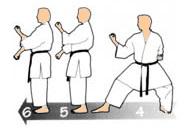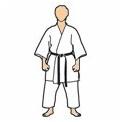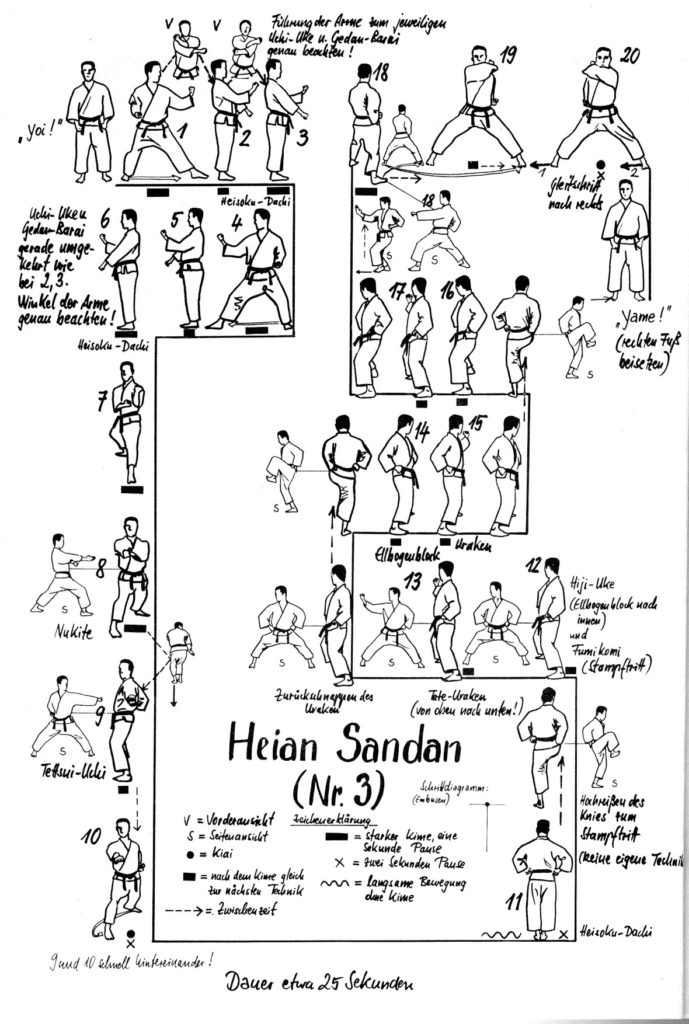The shortest kata in the Heian series, Heian Sandan has 20 movements and the embusen is almost I-shaped. This Kata is not as long or varied as Heian Nidan.
Heian Sandan is known for it’s four sets of fast, simultaneous block/strike combinations at the start of the Kata. This Kata has the first use of Kiba-dachi (horse riding stance) in a shotokan Kata, we see fumikomi (stamping kick) and spinning techniques for the first time. As with Heian Nidan there are several examples of simultaneous block/strike techniques in Heian Sandan.
HEIAN SANDAN
Peaceful Mind - third level
HEIAN SANDAN
Peaceful Mind - third level
Kata performed by Aragaki Misako
Some of the Key Moves:
- Kiba-dachi (horse stance)
- Heisoku-dachi (attention stance)
- Empi-uke (elbow block)
- Yori-ashi (shifting)
- Fumikomi (stomping step)
- Uchi-uke/Gedan-bari (simultaneous inside and down block)
- Tate-uraken (vertical backfist)
The word Heian is a combination of Heiwan that means "Peacefulness" and Antei that means "Calmness." For this reason the meaning of the Kata signifies a "Peaceful Mind." The name suggests that the student who has mastered the five Heian forms can be confident in his ability to defend himself, and hence would be able to adopt a state of "Peaceful Mind." The original versions of the Katas were named Pinan and were created by Master Itosu in the early 1900’s. Master Funakoshi, during the creation of the Shōtōkan style, changed the names of the Katas for reasons he explains in his book Karate-Do Kyohan:
The names of the kata have come down to us by word of mouth. Names in use in the past included Pinan, Seishan, Naifanchi, Wanshu, Chinto, and the like, many of which had ambiguous meanings and have led to frequent mistakes in instruction. Since karate is a Japanese martial art, there is no apparent reason for retaining these unfamiliar and in some cases unclear names of Chinese origin simply because of earlier usage. I have therefore changed those names I considered to be unsuitable after considering the figurative nature of the old masters’ descriptions of the Kata and my own study of them.
As mentioned above, there are five Heian Katas in all; Shodan, Nidan, Sandan, Yondan, and Godan. Shodan being the simplest and Godan the most complex.
The Kata Heian Nidan was originally the first of the series but Master Funakoshi, realising that this Kata was much harder then Heian Shodan, changed the order in which they are taught "after consideration of their various points of difficulty and ease of teaching."
HEIAN SANDAN
The Kata in practice
HEIAN SANDAN
The Kata in practice
Greet slowly in musubi-dachi position .
Announce the kata: "Heian Sandan" .
Yoi : In position hachiji-dachi , fists closed in front of the hips.
1 - Hidari chudan uchi-ude-uke: Turn the head to the left and move the left foot to the left in the kokutsu-dachi rear position , while blocking the inner edge of the left forearm middle level ( uchi-ude- uke ), the right fist in hikeness. Foot movement, kokutsu-dachi transition and blocking must be synchronized. The bust is in profile.
2 - Hidari gedan-barai / Migi chudan uchi-ude-uke:
- Group the right leg on the left leg, feet together, to stand up in heisoku-dachi ,
- Make a low block ( gedan-barai ) left, and a middle right lock from inside to outside (uchi-ude-uke )
- knees stay slightly bent.
- The double circular movement of the fists makes them close to the body, the left fist passing inside the right elbow. The spacing of the arms in the final position is equal to the width of the shoulders. The elbows serve as pivot and must move as little as possible; during the whole movement they remain distant from the trunk by a fist-width.
3 - Hidari chudan uchi-ude-uke / Migi gedan-barai: On the spot, invert the arms.
- Make a low blocking ( gedan-barai ) right, and a middle blocking left from inside to outside ( uchi-ude-uke )
- The knees remain slightly folded.
- The double circular movement of the fists makes them close to the body, the right fist passing inside the left elbow.
Times 2 and 3 are chained in a single sensation. The abdominals are contracted, the shoulders do not move

4 - Migi chudan uchi-ude-uke: Turn the head to the right and rotate 90 ° on the left foot by moving the right foot to switch to kokutsu-dachi , while blocking the internal cutting edge of the right forearm level medium ( uchi-ude-uke ), the left fist in hikeness.Foot movement, kokutsu-dachi transition and blocking must be synchronized. The bust is in profile.
5 - Hidari chudan uchi-ude-uke / Migi gedan-barai:
- Group the left leg on the right leg, feet together, to stand up in heisoku-dachi ,
- Make a low block ( gedan-barai ) right, and a middle left block from inside to outside ( uchi-ude-uke )
- knees stay slightly bent.
- The double circular movement of the fists makes them close to the body, the right fist passing inside the left elbow. The spacing of the arms in the final position is equal to the width of the shoulders. The elbows serve as pivot and must move as little as possible;during the whole movement they remain distant from the trunk by a fist-width.
6 - Hidari gedan-barai / Migi chudan uchi-ude-uke: On the spot, invert the arms.
- Do a low blocking ( gedan-barai ) left, and a middle right block from the inside out (uchi-ude-uke )
- The knees stay slightly bent.
- The double circular movement of the fists makes them close to the body, the left fist passing inside the right elbow.
Times 5 and 6 are chained in a single sensation. The abdominals are contracted, the shoulders do not move

7 - Hidari chudan morote-uke: Turn the head to the left and rotate 90 ° on the right foot by moving the left foot to switch tokokutsu-dachi in the main axis. Bet with a medium level double lock.The left arm performs the parry, the right fist, knuckles up, reinforces the inside of the left elbow ( morote-uke ).
8 - Migi chudan nukite-tate-zuki / Hidari osae-uke: Advance the right foot on the same axis, in zenkutsu-dachi with a vertical spike (tate-nukite ) of the right hand middle level, in a straight line over the left hand that you close in front of you during the passage forward (osae-uke ).
9 - Hidari chudan tettsui-yoko-uchi:
- Exercise a twist of your right arm in your back,
- Swivel on your right foot by moving the left foot to 180 ° to finish in kiba-dachi position , still in the main axis
- At the same time, hammer with medium left iron hammer ( yoko-tettsui-uchi )
10 - Migi chudan oï-zuki: Advance the right foot forward inzenkutsu-dachi striking with a direct punch to the plexus ( oï-zuki )
KIAÏ !!!

11 - Ryoken-koshi-kamae: Change of rhythm. Raise up and slowly rotate 180 degrees backwards, bringing the left foot back to the right foot. Stabilize yourself in heisoku-dachi position . The 2 fists (ryoken) are placed firmly on the hips, in ryoken-koshi-kamae posture.
12 - Migi yoko-fumikomi / Migi yoko-empi-uchi: Pivot on the left foot 90 ° to the left, raising the right knee very high, fists on the hips.
Fold the right foot into power (yoko-fumikomi) ending the pivot and arriving inkiba-dachi.
The right elbow strikes forward at the same time (yoko-empi-uchi).
13 - Migi jodan uraken-tate-uchi: On the spot strike circularly with the back of the right fist in a vertical plane ( tate-uraken-uchi), before bringing the right fist to the belt.
14 - Hidari yoko-fumikomi / Hidari yoko-empi-uchi: Pivot on the right foot of 180 ° to the right by raising very high the left knee, fists to the hips.
Close the left foot in power ( yoko-fumikomi ) ending the pivot and arriving in kiba-dachi . The left elbow strikes forward at the same time ( yoko-empi-uchi ).
15 - Hidari jodan uraken-tate-uchi: On the spot, strike circularly with the back of the left fist in a vertical plane ( tate-uraken-uchi ), before bringing the left fist to the belt.
16 - Migi yoko-fumikomi / Migi yoko-empi-uchi: Pivot on the left foot of 180 ° to the left by raising very high the right knee, fists with the hips.
Fold the right foot into power (yoko-fumikomi) ending the pivot and arriving inkiba-dachi.
The right elbow strikes forward at the same time (yoko-empi-uchi).
17 - Migi jodan uraken-tate-uchi: On the spot, strike circularly with the back of the right fist in a vertical plane ( tate-uraken-uchi), before bringing the right fist to the belt.
18 - Hidari tate-shuto-uke: On the spot, execute very slowly and with concentration a chudan blocking of the sword of the hand (shuto-uke ), the left fist slowly returning in hikité. Inhale during the whole movement.
19 - Hidari chudan oï-zuki: Advance the left foot forward inzenkutsu-dachi by striking with a direct punch to the plexus ( oï-zuki) left.

20 - Migi jodan tate-zuki / Hidari ushiro-empi-uchi:
- Bring the right leg to the left in the small position kiba-dachi
- Perform a fast rotation on the right foot of 180 ° to finish in position kiba-dachi .
- At the same time, give a right punch turning over your left shoulder high ( tate-zuki ) and send a left elbow back ( ushiro-empi-uchi ) simultaneously.
The right hand attacks the opponent's head behind you and the left fist attacks the hip.
21 - Migi jodan tate-zuki / Hidari ushiro-empi-uchi:
- Slightly move the position to the right, keeping the same position kiba-dachi
- Run a left punch turning over your right shoulder high level ( tate -zuki ) and send a straight back elbow ( ushiro-empi-uchi ) simultaneously.
The left hand attacks the opponent's head behind you and the right fist attacks the hip.


KIAÏ !!!

Yame in position hachiji-dachi.







